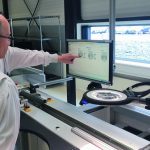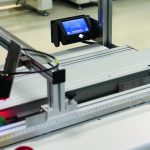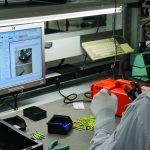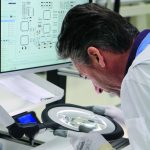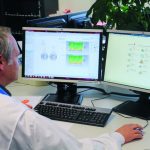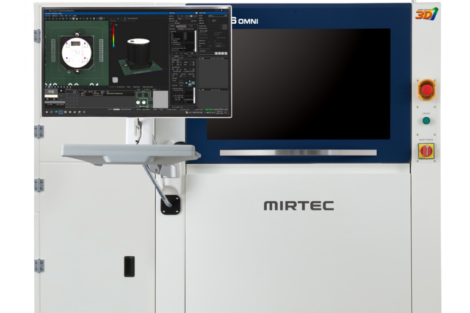This paper explores the path TBP took to arrive at their exceptional level of MES system integration throughout their factory. It first explores the business requirements that led TBP to seek a factory-wide software system, their selection approach, insights on deployment, the results gained from the deployment, and the business benefits of the project.
CEO Ton Plooy started making printed circuit boards long before CAD, SMT, and manufacturing software. Back then, in his small one-man shop, he used red and blue tapes to trace the layers of connection between through-hole component pads. Fast forward forty years and TBP, in The Netherlands, is one of the most automated and impressive electronic manufacturing facilities you’ll find in Europe, providing a broad range of customer focused manufacturing services. This is the type of operation where the business focus on quality is apparent even as you approach the factory, enter the lobby, and view the factory floor from afar. The facilities reflect the corporate culture of either doing something properly or not at all. They are now turning over more than € 23Million with over 120 skilled staff and operating in the most demanding of electronics markets, such as medical, semiconductor and petrochemical.
TBP stands for “The Business of Perfection” and it’s this constant pursuit of perfection that has driven the team to develop a facility and a methodology to deliver the right product, on time, every time – resulting in the kind of growth that only comes with complete customer satisfaction.
Business driver to explore an MES system
TBP have always prided themselves on investing in the best equipment and solutions, believing that this reflects in the quality of their offering. Ton Plooy said: “We want to be right at the front of technology, leading our peers and informing the market of new ideas. This is reflected in every investment we make. We are thorough in our vendor selections and we invest in the very best in each area of our operation.”
TBP already had in place world-class factory assets when they turned their attention to integrating them together with a Manufacturing Execution Software system. The operation included an impressive, fully automated warehouse, a factory full of current and data-rich assembly and process machines, and excellent computer infrastructure throughout. A world-class factory needing to connect all those assets digitally and bring TBP the speed, control and data visibility that only a software system can provide. When the comapny turned their attention to such software, it was not to fix issues in their operation, but to bring increased automation, control, data analytics and adaptability.
The system selection process
List of requirements for their manufacturing operations software included:
- A desire to be on the leading edge and a belief that this is one of their unique selling points, allowing them to clearly differentiate themselves amongst their competitors;
- A system that can adapt to an extremely high-mix, low-volume business with batch sizes ranging from a single unit up to 2000;
- The flexibility to convert a wide variety of CAD and BOM (Bill of Materials) formats into interactive operator work instructions and machine programs for their entire operation;
- The capacity to acquire and normalize production data from all human and machine interfaces on the shop floor using an open and proven machine communication technology.
- The capability to collect quality data and drive repair processes using the digital image of the product, and to deliver this capability via machine inspection or operator input equally effectively.
- The capability to record the parts, materials and manufacturing processes used in each assembly and sub-assembly to support their customer requirements for traceability;
- The ability to quickly and easily drill down into this data in order to, a) immediately react to issues in production, and b) digitally archive the specific processes and materials used for each unit in every job.
Very few MES suppliers could satisfy TBP’s support requirements involving specific electronics-assembly capabilities, an established European install base, and local, directly staffed European offices. As such they were able to review a small number of vendors in great detail. Following an intense evaluation, their decision to choose Aegis became clear.
Rolf Nagtzaam, TBP’s IT Project Manager said about the selection process: “We chose Aegis because they are very open with data. From the moment we import our customers design files to the time we pack and ship our final product, Aegis allows us to read, record, and relay data across our entire factory. This high level of connectivity between systems, operators, and machines enables us to react quickly and intelligently to changes or problems in manufacturing.”
Factory-wide deployment – one step at a time
Deploying software throughout an organization is never simple, but it was a success at TBP largely because they took a collaborative approach with Aegis, working closely together to ensure that implementation was undertaken in sensible phases, rather than trying to change everything overnight.
“Working step-by-step with the Aegis training and deployment team was vital to us.” stated Ton. “Once our users learned how to configure and use one part of the system, they could see the benefits for their daily work and then get excited about the next phase of the deployment. Most of our people have been here for many years and we treat them like family, so it is important to make them feel like the software is truly their application.”
The TBP deployment again revealed the Company’s belief in perfection. TBP engineering was focused on gaining maximum benefit from every aspect of the system, rather than deploying in a minimal manner. Further, project management of such a deployment is critical—but it is not only a matter of the vendor delivering good project management, and TBP understands this. The customer side of tracking the project, issues along the way, and marshalling resources was a key element in success. Real commitment and investment in supporting the rollout is critical, and TBP, once again, invested to achieve their goals.
Benefits of the deployment
New job launches in hours instead of days: With batch sizes as small as a single unit, fast job launches are critical to competitiveness and profitability. Aegis’ ability to read in virtually any type of customer CAD and BOM data is instrumental to this process, and their revision control system of both BOM and processes ensures that the right job is being built on the right line, at the right time.
“Our initial Aegis deployment reduced the time required to prepare our product launches by 40%, and with further optimization, we are now able to release new jobs to production in less than 4 hours.” commented Nagtzaam. “Their software allows our engineers to generate programs for all of our process, assembly, inspection, and test equipment from a single system. Aegis runtime programs can be read in by all of our machine models and vendors.” Rolf reflected.
Complete tracking and control of production: To achieve production flow control and tracking, TBP utilizes the Aegis system via several technologies. At hand stations, the graphical interface combined with off-the-shelf scanners enforces and tracks unit movement. On conveyorized lines, the system gathers tracking data from the production machines, but also via Aegis inForce line terminals to ensure 100 % barcode read rates, and to automatically interlock conveyors if a process drifts or a reroute is required. This ensures that each assembly is in the correct location in the production process, and physically cannot proceed if there is an issue. If a unit is not in the correct location, a scan fails to get an ID of a unit, or a process condition even from the end of the process is designated to stop flow, the inForce conveyor controller will temporarily halt production. Its full-color, touch screen monitor will sound an alarm and display a human-readable alert, notifying the operator of the specific issue. All of this WIP (Work in Process) data is recorded in the Aegis database, relayed to real-time production dashboards, and archived for historical analysis and traceability.
In addition to tracking and controlling the movement of assemblies through the production process, the company also uses Aegis software to read and record the machine state and runtime data from their equipment. Aegis xLink adapters translate the proprietary data streams coming from the various assembly robots, testers, and inspection machines into a standards-based XML data format that Aegis’ servers inherently understand. When an assembly gets to a manual workstation, the user scans the assembly’s barcode and their shop floor terminal instantly displays the interactive digital work instructions that were created in the NPI software for that specific location and job.
“One of the reasons we chose Aegis is because their visual aids are much more than just static PDF instructions found in most other systems.” noted Nagtzaam. “They are dynamic, searchable guides that allows our operators to watch videos, listen to recorded audio, and interact with the design of the assembly at a much deeper level.”
In addition to aiding manual assembly, Aegis shop floor terminals also enable CAD-aware quality data collection and repair assistance. TBP inspectors record defects on an intelligent rendering of the assembly which allows their engineers to conduct a visual analysis of quality across the surface of the product while mapping defects to specific elements of the design.
“When a defective assembly arrives at the repair location we predefined during the NPI process, our rework operator scans the unit and their shop floor terminal clearly displays where the fix needs to occur on a detailed visual of the product. This repair is recorded and then the unit moves back through the rest of the assembly process.” explains Rolf. This greatly reduces the amount of scrapped material, rework time, and labor costs associated with our repairs.”
Transforming data into manufacturing intelligence: TBP realized early on that Aegis’ ability to read, record and relay data to and from the shop floor would have very limited benefit if that data couldn’t easily be turned into timely and useful information that they could react upon. They needed a reporting system that was powerful but also very easy to set up and use.
“The simple drag-and-drop configuration of the Aegis analytics system allows our manufacturing team to rapidly develop the outputs they need on their own, without having to constantly rely on our IT staff for coding or to write complicated database queries for our reports. The Aegis analytics system allows us to react quickly to the changing needs of our customers, and was an important factor in our selection of Aegis.” CEO Plooy stated.
The company uses Aegis Analytics to create real-time dashboards displaying proactive information that allows engineers and operators to immediately react to changing conditions on the shop floor. They also use the system to generate scheduled reports for WIP and quality that run automatically with no user intervention.
“Once our users saw how helpful this information was in doing their job, they really embraced building their own dashboards.” Rolf elaborated. “So far they have created over 35 dashboard types with most taking less than an hour to build.”
Measurable improvments in speed, control and visibility
- Reduced new product introductions (NPI) from an average of 16 hours to 4 hours.
- Improved process-related yield by 1.6 % since deployment.
- 3 % reduction in defective parts per million (DPMO).
- Average assembly rework time dropped 33 %.
- Level-4 component traceability all the way down to individual reference designators.
- 35 dashboards and reports with an average development time of 1 hour.
- Industry 4.0 is the subject of widespread interest in both manufacturing and European political discussion regarding industry in general. The concept is to achieve a factory that dynamically adapts to incoming product variants and process changes while automatically and proactively improving manufacturing processes. These “smart factories” are built on a data backbone that enables their intelligent factory assets – both human and robotic – to communicate information and instructions bi-directionally. TBP believes that Aegis is already positioned to provide this capability.
TBP is Industry 4.0 ready
“Aegis’ xLink technology already allows our machines and operators to communicate to their server using a standardized data format.” commented Mr. Plooy. “And the push towards Industry 4.0 is driving our equipment vendors to develop intelligent machines with the ability to react to inputs from one another. Aegis is also partnered with many of these manufacturers and we look forward to seeing how they all work together to help us achieve “The Business of Perfection”.
The building blocks of the Industry 4.0 solution at TBP are all in place save one: when the machines and assets in the factory subscribe to the real-time analytics in the Aegis system to react to that data to make their own adaptive decisions, the total 4.0 vision will be reality at TBP.
Conclusion
The world-class integrated factory TBP enjoys today is as much the result of the system they implanted as it is the culture of their business. Their focus on perfection in all that they do influenced every step on their road to such as system and resulted in success.It guided an informed selection process that was based on clear business and functional goals combined with an understanding of IT architecture. It motivated them to allocate adequate internal resources and project management during deployment, and it drove true and full adoption of the solution throughout the enterprise. The Aegis deployment in the TBP enterprise demonstrates what can be achieved when such a corporate culture implements a manufacturing execution system.
Share:



